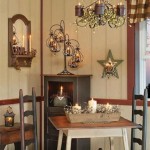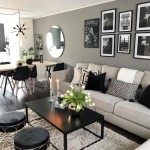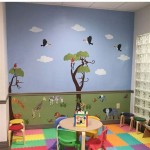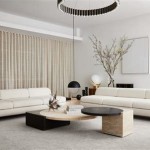How to Decorate Your Room on a Budget
Decorating a room does not need to be an expensive endeavor. With careful planning and a bit of creativity, it is possible to transform a living space into a personalized and comfortable haven without breaking the bank. The process involves a combination of strategic resource allocation, DIY projects, and a keen eye for finding affordable décor options.
Planning and Prioritization
Before embarking on any decorating project, a thorough assessment of the existing room is essential. This includes noting the room's dimensions, existing furniture pieces, natural lighting, and any architectural features. An understanding of these elements will inform subsequent design choices. A budget should be established at the outset, outlining the total amount of money allocated for the project. This will serve as a guideline, helping to prioritize spending and avoid overspending.
Once the budget is set, it is necessary to prioritize the spending categories. This could involve determining which aspects of the room require the most attention. For example, if the walls are bare and unappealing, painting or wallpapering might take precedence over new furniture. Alternatively, if the lighting is inadequate, investing in new lamps or light fixtures may be the primary focus. Prioritization ensures that the most impactful changes are addressed first, maximizing the visual impact of the renovation.
A mood board can be an invaluable tool during the planning phase. This visual representation of the desired aesthetic provides a reference point throughout the decorating process. A mood board can include color palettes, images of furniture styles, fabric swatches, and any other elements that contribute to the overall design concept. Creating a mood board can be accomplished physically using magazines and fabric samples or digitally using online design tools. It facilitates cohesive decision-making and prevents impulsive purchases that might deviate from the intended design.
Affordable Decorating Techniques
Paint is one of the most cost-effective ways to transform a room. A fresh coat of paint can instantly brighten up a space, cover up imperfections, and create a new ambiance. When selecting paint colors, consider the room's size, natural lighting, and intended use. Lighter colors can make a small room appear larger, while darker colors can create a more intimate and cozy atmosphere. Consider purchasing paint during sales or opting for slightly imperfect "oops paints," which are often sold at a discounted price. Applying paint oneself rather than hiring a professional further reduces the cost.
Repurposing existing furniture is another effective way to save money. Instead of buying new pieces, consider refinishing, reupholstering, or simply rearranging the furniture that is already available. A worn-out dresser can be transformed with a fresh coat of paint and new hardware. An old chair can be given a new lease on life with a new fabric covering. Rearranging furniture can also create a completely different look and feel for the room without spending any money. Think creatively about the function of existing pieces and explore alternative uses.
Utilizing affordable wall decor can add personality and visual interest to a room. Instead of expensive artwork, explore alternative options such as prints, posters, or DIY wall art. Thrift stores and flea markets are excellent sources for finding unique and affordable artwork. Creating DIY wall art can be a fun and cost-effective project. Examples include framing fabric scraps, creating gallery walls with family photos, or painting abstract designs on canvas. Using found objects, such as driftwood or branches, can also create unique and eye-catching wall decor.
Textiles can significantly impact the look and feel of a room. Affordable options include throw pillows, blankets, curtains, and rugs. Changing these items can instantly update the room's color scheme and add texture and warmth. Consider purchasing textiles on sale or at discount stores. Sewing skills can be used to create custom throw pillows or curtains from inexpensive fabric. Layering rugs can add visual interest and define different areas within the room. Choosing neutral-colored furniture allows for greater flexibility when updating textiles, as they can be easily swapped out to reflect seasonal trends or personal preferences.
Strategic Shopping and DIY Projects
Thrift stores, flea markets, and online marketplaces are treasure troves for finding unique and affordable décor. These sources often offer vintage furniture, art, and accessories at significantly lower prices than retail stores. The key is to be patient and willing to invest time in searching for hidden gems. Examine items carefully for structural integrity and potential for refurbishment. Negotiation is often possible at these venues, further reducing the cost. Visiting these locations regularly can increase the chances of finding the perfect piece at a bargain price.
Garage sales and estate sales provide another opportunity to find affordable furniture and décor. These sales often feature items that are heavily discounted, as the sellers are looking to declutter their homes. Arriving early at these sales can increase the chances of finding the best items. Be prepared to haggle and negotiate prices. Bring cash to facilitate quicker transactions. These sales can be a great source for finding unique and eclectic pieces that add character to a room.
Do-it-yourself (DIY) projects can significantly reduce decorating costs. Numerous online resources provide tutorials for creating various décor items, from wall art to furniture. Examples include building shelves from reclaimed wood, creating decorative mirrors from dollar store supplies, or sewing custom curtains and pillow covers. DIY projects allow for personalization and customization, ensuring that the décor reflects individual style and preferences. Engaging in DIY projects can also be a fun and rewarding experience.
Upcycling is a sustainable and cost-effective way to decorate a room. This involves transforming old or unwanted items into new and useful décor pieces. Examples include turning old jars into vases, repurposing wooden pallets into furniture, or creating lamps from vintage bottles. Upcycling reduces waste and adds a unique and personal touch to the room's decor. It also encourages creativity and resourcefulness, promoting a more sustainable lifestyle.
Utilizing natural elements can add a touch of organic beauty to a room without spending money. This includes incorporating plants, flowers, and natural materials such as wood, stone, and shells. Plants can purify the air and add a sense of tranquility to the space. Flowers can add color and fragrance. Found objects, such as seashells or driftwood, can be used to create decorative displays. Foraging for natural elements can be a fun and cost-free activity. However, attention should be paid to local regulations regarding the collection of natural materials.
Strategic use of lighting can significantly impact the ambiance of a room. Instead of purchasing expensive new light fixtures, consider replacing existing bulbs with energy-efficient LED bulbs. These bulbs consume less energy and last longer, saving money in the long run. Adding lamps to different areas of the room can create a more layered and inviting lighting scheme. Fairy lights or string lights can add a touch of whimsy and create a cozy atmosphere. Position mirrors strategically to reflect light and make the room appear brighter and larger.
When purchasing items for the room, it is advisable to compare prices from different retailers. Online price comparison tools can help identify the best deals. Look for sales, discounts, and coupons. Consider purchasing items in bulk if possible, as this often results in lower prices per unit. Sign up for email newsletters from retailers to receive exclusive discounts and promotions. Being a savvy shopper can save a significant amount of money on decorating expenses.

8 Design Ideas For Your New Rec Room L Esseiale

How To Customize Your Dorm Room Rec

How To Customize Your Dorm Room Official Rec Guide

Rec Room Design Ideas For Some Fancy Time At Home Decoist

Basement Rec Room Ideas

30 Outstanding Rec Room Ideas To Maximize Your Home Space Decor Game Design

Rec Room Design Ideas For Some Fancy Time At Home Decoist

Basement Rec Room Ideas

Create An Awesome Home Game Room With These 26 Ideas Extra Space Storage

How To Customize Your Dorm Room Rec







